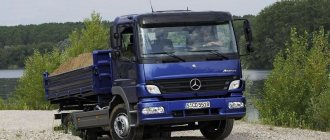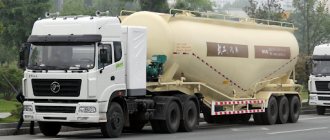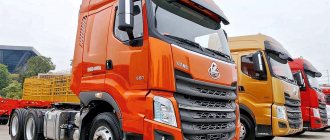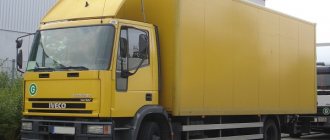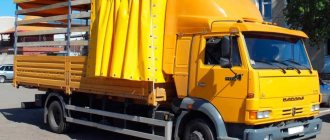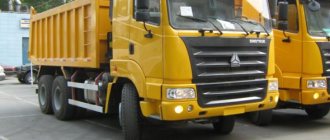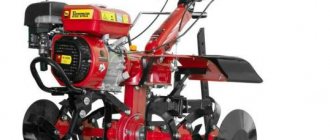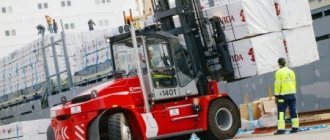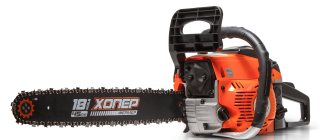Japanese trucks, like American ones, have long been established on domestic roads. They are famous for their good quality and long service life. Many trucks in this country are capable of not only being a special vehicle for transporting large masses, but also being a common transport device. Considering that the Japanese are very conservative people, they try to use all available resources to the maximum. This is reflected in the quality of cars. They are not only functional, easy to use and relatively inexpensive, but also have their own characteristics. Let's look at some options.
The best Japanese trucks
Details Category: News Published 05/28/2019
The Japanese auto industry deservedly enjoys high prestige throughout the world, both among private car owners and among the professional community of motorists and auto repair specialists. Japanese trucks, as well as cars, are rightfully considered the best in terms of affordable cost and fairly high quality.
The meticulousness of the Japanese in working on the design and production of trucks is comparable to their German colleagues, but at the same time, the prices of even the best Japanese trucks are significantly lower than their counterparts from Germany. This was the main reason for the widespread popularity in our country and around the world of trucks made in Japan.
"Nissan"
The Nissan concern is famous for its light-duty trucks. Vivid examples include the Navara and Datsun models. The first one needs to be discussed in more detail, because even now it is actively attracting the interest of consumers. Moreover, spare parts for Japanese trucks of this brand can be purchased at almost any service center.
The truck's power is 232 hp. s., engine capacity – 3 liters. It received such characteristics after restyling in 2010. You can tow a trailer that can carry 3 tons of cargo.
The Datsun model was produced for a long time with a 75-liter gas tank. The cabin is quite comfortable, and the body has a beautiful design.
Selection criteria for Japanese trucks
The choice of truck model depends on the required load capacity, power and expected operating conditions. Such criteria made it possible to divide all Japanese trucks into three main classes:
- light (small-tonnage vehicles) – up to 4 tons;
- medium (five-tonners);
- heavy (ten-ton trucks).
Each of the classes is divided into a number of categories depending on the type of cargo transported, the type of cargo compartment, the presence of a manipulator, etc.
Light class
Most motorists and professional auto mechanics consider vehicles of four main brands and their models to be among the most reliable Japanese trucks in this category:
- Isuzu ELF;
- Mitsubishi Canter;
- Mazda Titan;
- Toyota TownAce or LiteAce;
- Nissan Vanette.
Isuzu ELF models, starting from 1993, occupy high positions in the ranking among Japanese trucks with a carrying capacity of 1 to 4 tons. In some countries this model line is called N-series. The variety of various modifications makes it possible to choose the optimal option for a particular case.
Mitsubishi Canter is also considered one of the best Japanese trucks. Impressive appearance, large glass area, comfortable interior and impeccable performance of power units are the main advantages of this series. Mazda's small-tonne Titan model range has similar positive features.
Among Japanese light-duty trucks with a carrying capacity of 1-2 tons, the TownAce or LiteAce series vehicles from Toyota are especially popular, which are assembled on the basis of minibuses of the same model line, ToyoAce and HiAce light-tonnage vehicles, or higher-capacity Dyna series vehicles. Low-ton Japanese Nissan Vanette trucks, based on minibuses, are also produced using a similar principle.
All of the listed series of trucks manufactured in Japan are presented in a wide variety of commercial applications:
- onboard vehicles;
- refrigerators;
- vans with a volume of up to 16 m³;
- dump trucks.
Additionally, each of these reliable Japanese trucks can be equipped with a crane. In most cases, cars are equipped with 1.8-5 liter diesel engines. Cabin capacity is from 2 to 7 people.
Five-tonners
Among the most reliable Japanese middle-class trucks, the following cars deservedly enjoy authority:
- Mitsubishi Fighter Mignon and Fuso;
- Isuzu Forward Juston;
- Nissan Diesel;
- Hino Condor, Forward, Fighter and Ranger.
Such cars are equipped with a 7-8-liter diesel engine and a 6-speed manual transmission. Among the listed models of Japanese five-ton trucks there are all the main types of cargo compartment:
- dump trucks;
- flatbed trucks;
- vans;
- automixers.
Between the medium and heavy classes of trucks, there are a number of two-axle vehicles with a load capacity of up to 8 tons. The presence of “20” wheels is the main advantage of such trucks. However, they are not so common and are usually supplied by special order.
Heavy class
Japanese ten-ton trucks are available in both three- and four-axle versions. Such trucks are produced with a 6x2 or 6x4 wheel arrangement for refrigerators, automixers, dump trucks, etc. At the same time, the Japanese auto industry makes it possible to produce a special order truck with an 8x4 wheel formula, nicknamed among motorists the “centipede.”
Some of the most reliable Japanese heavy-duty trucks are:
- Nissan Diesel;
- Isuzu;
- Mitsubishi Fuso;
- Hino.
Japanese automakers have a special perspective on the design and production of engines for multi-ton trucks. As a result, almost all ten-ton trucks are equipped with engines with turbochargers and an increased combustion chamber volume. The range of engine displacement starts from 9 liters in turbodiesels, up to 26 liters in engine units with a V-shaped cylinder arrangement.
Hino 300
The Hino company entered the domestic market back in 2008, but for a long time could not establish itself in it. This is due to the severe crisis of that period. There are three series on sale in Russia: 300, 700, 500. The first of them consists of comfortable, popular, safe and the lightest environmentally friendly trucks. There are two modifications of this series on the market, each differing from each other in technical characteristics and having three different options. Thus, the buyer can choose from six cars.
Japanese Hino trucks are equipped with their own spare parts, including the engine. Modern 300 series models are equipped with units that comply with Euro 3/4 standards. Power – 150 l. With. Fuel consumption is about 17 liters per 100 km. Load capacity is 4.5 tons. The gearbox is mechanical. There is no all-wheel drive.
Engine oil
The j08c engine must be filled with at least 13.5 liters of oil when changing. This is based on the calculation that 1.7 liters will go to the filter and 11.5 liters to the crankcase. As for the quality of the lubricant, because of the Common Rail, formulations with strict requirements for sulfated ash content must be filled here. If you turn off the EGR, you can safely pour CJ-4-8. It is recommended to purchase only original Toyota ones.
"Nissan Atlas"
Under the brand that received this name, Japanese trucks are produced, differing in their technical characteristics. The first thing that catches your eye is the size of the wheels. They stand out a lot. If we consider the engines that are installed on trucks, then it should be noted that they are of two types: gasoline (NA) and diesel (TD, BD, FD). The suspension is absolutely typical for Japanese cars. The Atlas family includes trucks weighing 3.1 and 3.4 tons. The wheelbase can be either extended or standard. Most engines produce 130 hp. With.
LUNGS
This most common range of trucks in Japan makes up up to half of the total vehicle fleet, having a number of features.
Firstly, developed cooperation is unusual for other countries. It is not surprising, given the common owner, that the Toyota Dyna - Hino Dutro - Daihatsu Delta line is unified. But the situation with other manufacturers is unique. For example, Isuzu, in addition to its wide range of Elf and export brands Reward, Chevrolet, GMC, as mentioned earlier, also assembles cars under the Mazda Titan, Nissan Atlas and UD Condor brands.
Secondly, some cars of this class, mainly operating in megacities, are equipped with engines running on alternative fuels. In addition to compressed gas (CNG) or liquefied gas (LPG) engines, hybrid and diesel-electric engines are used.
In addition, light trucks use an unusually large range of cabin widths. Different versions of the Isuzu Elf alone are called single, standard, high, wide, narrow.
Mercedes Benz Atego
The model is produced in a number of variants with different wheelbase lengths and suspension modifications. They can be intended for urban use, suburban transportation, for special equipment, etc.
Among the shortcomings, we note the relative high cost of components and the trucks themselves. Difficulties may arise if the electrical system needs to be repaired.
JUNIOR
The lightest Mini class includes models developed specifically for Japan and produced by passenger car concerns. Some of them are ordinary passenger cars of a particularly small class in 2-, 3- and 5-door configurations with dismantled rear seats (for example, Toyota Corolla, Nissan Sunny). But besides them, there is a special class, originally developed as commercial products. Badge-engineering is very popular in this class - the same cars have different names. Nissan Clipper is also sold as Mitsubishi Minicab, Suzuki Every is sold as Mazda Scrum. Similar cars are produced by Subaru, Daihatsu (including Toyota versions) and Honda.
This class also includes mid-size vans with a carrying capacity of up to 1200 kg, which are also known here: Toyota Hi Ace, Nissan Caravan (Urvan) and others.
Owner reviews
Let's now listen to the owners of cars with this engine.
Yakov Shim, Novosibirsk
“The legendary j08c is the reason I bought my Hino Ranger. A long time ago, when a dollar cost 25 rubles - in March 2008, I managed to purchase a 2002 truck in Vladik. In addition to a reliable internal combustion engine, I got the simplest fuel equipment, ABS, air conditioning, a rear view camera and a cabin without a sleeping bag. What can I say - with such an engine the car is more suitable for the city, since after 2000 rpm the tachometer's white zone begins, and after 3100 - the red zone. However, in principle there is enough speed on the track.”
Zaton, Barnaul
“I once drove a ’95 Hinorem. The cabin was equipped with a sleeping bag and carried all 11 tons (although the rated load capacity is 8 tons). The engine rushes like a tank on flat roads, but on hills you have to change gears more often. Overall, I was happy as an elephant, but the speedometer cable began to wobble, and it kept breaking.”
John, USSR
“Forces are the weak point of this engine. Before finishing off the beam equipment with water, I replaced all the nozzles. Then, carelessly, I poured water into the sump and filter with all the consequences. In general, change the injectors on time - and you will be happy.”
Hyundai HD
The South Korean Hyundai truck has been in demand among domestic merchants for several years. The appearance of the first of them dates back to 2004, and today they have become common means of transport in city traffic. It is worth paying special attention to the HD-65, 72, 78 families. They are easy to operate and highly maintainable.
Widely used in various types of transportation, retail and wholesale business. Industrial enterprises and trucking companies have long paid attention to this manufacturer, given its affordability. With the help of his cars it is possible to transport decent quantities of goods at relatively low cost. The 4-liter engine consumes 20 liters per 100 kilometers.
Mazda 2.0 MZR-CD
Short description:
— 4-cylinder
— 16-valve
— Common Rail power system
— turbocharging
— for compact and mid-class passenger cars and minivans
The history of Mazda 2-liter diesel engines (RF family) dates back to the eighties of the last century. He had quite a lot of non-standard solutions. For example, supercharging was carried out using a Comprex-type compressor, which uses exhaust gas pulses to compress air, acting directly on the air flow supplied to the engine. In 1998, direct fuel injection appeared and the engine received the designation DiTD.
In 2002, the MZR-CD debuted. The engine has a common rail injection system manufactured by Denso and operating at a pressure of 1800 bar. This allows the fuel dose to be divided into smaller parts, which ensures smoother engine operation. The diesel engine is equipped with a dual-mass flywheel, a variable geometry turbocharger and a timing belt drive.
Along with the restyling of the first generation Mazda 6 in 2005, the MZR-CD diesel engine was also updated. The compression ratio was reduced, a turbocharger with lower inertia was installed, and the injection system with nozzles was changed. From this time on, the use of a particulate filter began.
The latest version 2.0 MZR-CD appeared in 2007. As a result of software adjustments, injection control and exhaust gas recirculation system operation have become more efficient. As a result, fuel consumption decreased slightly, and a modified DPF filter reduced the toxicity of exhaust gases. The receiver of the 2-liter diesel engine received a larger capacity - 2.2 liters.
Operation and typical malfunctions
There has been a lot of controversy surrounding this engine. On the one hand, the owners could not find any shortcomings and were pleased with the moderate fuel consumption and fairly good dynamics. On the other hand, many have encountered numerous and very serious malfunctions. One way to protect yourself from trouble is to purchase a car from an owner who paid due attention to the engine and complied with all the necessary conditions for its maintenance. Otherwise, you will have to reckon with the malfunctions typical for this engine.
Oil intake clogged
Exceeding the oil change period and using low-quality lubricants are the main causes of clogging of the sieve through which the oil is taken. After purchasing a car, it is advisable to remove the engine pan and check the condition of the oil intake. If the problem is not detected in time, then difficulties with lubrication of the engine will soon appear, which can quickly lead to its jamming.
Defective fuel injector washers
They must be replaced after every operation on the injectors. The washers quickly lose their tightness, which allows gases and carbon deposits to enter the oil, and subsequently accelerates the process of clogging the oil intake.
SCV valve malfunction
Cars manufactured in the early years, up to around 2005, often suffered from a faulty idle air valve. A typical symptom is that the engine stalls after releasing the gas.
Increasing engine oil level
Since 2005, 2.0 MZR-CD engines have been required to be equipped with a particulate filter. A standard problem with early DPFs was that an unsuccessful attempt to clean the cartridge led to dilution of the oil with fuel.
Technical specifications Mazda 2.0 MZR-CD
| Version | 2.0 MZR-CD - 121 | 2.0 MZR-CD - 121 | 2.0 MZR-CD - 136 | 2.0 MZR-CD - 140 | 2.0 MZR-CD - 143 |
| Injection system | Common Rail | Common Rail | Common Rail | Common Rail | Common Rail |
| Working volume | 1998 cm3 | 1998 cm3 | 1998 cm3 | 1998 cm3 | 1998 cm3 |
| Cylinder arrangement/number of valves | R4/16 | R4/16 | R4/16 | R4/16 | R4/16 |
| Power | 121 hp/3500 | 121 hp/3500 | 136 hp/3500 | 140 hp/3500 | 143 hp/3500 |
| Max. torque | 310 Nm/2000 | 320 Nm/2000 | 310 Nm/2000 | 330Nm/2000 | 360 Nm/2000 |
| Timing drive | belt | belt | belt | belt | belt |
Application of 2.0 MZR-CD
The diesel engine is widely used in Mazda models: two generations of minivans and middle-class cars, and one compact car.
Mazda 3: 12.2006-06.2009
Mazda 5: 03.2005-09.2010
Mazda 6: 08.2002-08.2007
Mazda 6: 08.2007-12.2012
Mazda MPV: 07.2002-02.2006
Grade: ☆☆☆
Quite often, lubrication problems recur, which can even lead to engine seizure. Therefore, you must be careful when choosing a car with a 2.0 MZR-CD engine. It is better to choose a car whose history is well known.
Alternative
If not a 2-liter diesel, then a 2-liter gasoline engine is better. The supply of Mazda diesel engines from this period is very limited.
Pros of the j08c engine
Let's consider the advantages of this power unit:
- Japanese reliability - this company has a lot of experience in the production of heavy engines;
- high power - an excellent opportunity for large trucks and various special equipment;
- direct fuel injection - this ensures high engine efficiency and at the same time efficiency, low noise, and increased torque;
- the presence of one camshaft in the cylinder head means simplicity and low cost of maintenance.
